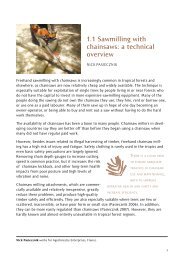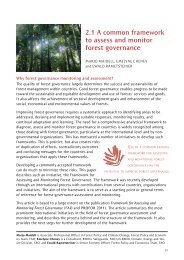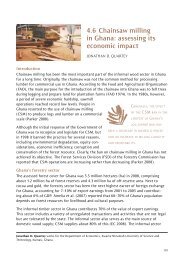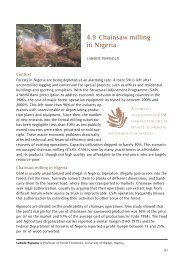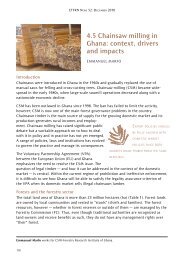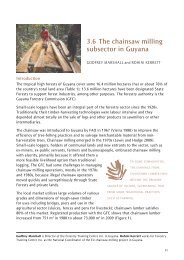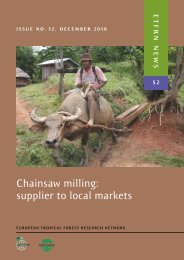Chainsaw milling: supplier to local markets - European Tropical ...
Chainsaw milling: supplier to local markets - European Tropical ...
Chainsaw milling: supplier to local markets - European Tropical ...
Create successful ePaper yourself
Turn your PDF publications into a flip-book with our unique Google optimized e-Paper software.
24<br />
ETFRN NEws 52: DEcEmbER 2010<br />
before merauke regency was divided in 2002 in<strong>to</strong> four regencies (asmat, boven Digoel,<br />
mappi and merauke), the forestry sec<strong>to</strong>r was the main source of its income (merauke<br />
regency planning agency 2008). There were 11 logging concessions in natural forest,<br />
covering 2,663,400 ha, from which the annual allowable Cut (aaC) was set at 1.3<br />
million m 3 /year. Ten industrial timber plantations (Hutan Tanaman Industri, or hTi) covered<br />
1.3 million ha, although none of them were fully established. before the onset of special<br />
au<strong>to</strong>nomy in 2001, merauke regency had two plywood mills with combined capacity of<br />
200,000 m 3 /year 1 and many sawmills. in 2002, all hph concessions and plywood mills were<br />
located outside the merauke regency and most of the inactive hTi plantations remained<br />
in the smaller merauke regency.<br />
in 2005, merauke regency produced 1,050 m 3 of sawn wood. Just one year later, in 2006,<br />
only 440 m 3 of sawnwood was recorded (merauke regency Forestry agency 2007). agency<br />
staff explained that this was a result of the ohl operation, which reduced the supply of<br />
raw material. in the same year the police confiscated 8,580 m 3 of illegal timber. This is an<br />
enormous increase in comparison <strong>to</strong> 2004, when the police seized only 16 m 3 (merauke<br />
regency Forestry agency 2007).<br />
During this period the population of merauke regency is continuously increasing, particularly<br />
as a result of incoming migration. This contributes <strong>to</strong> a steadily increasing demand<br />
for wood for housing. a large gap exists between the rising demand for wood and the lack<br />
of sources of legal wood, exacerbated by a lack of response or planning by government<br />
policy-makers <strong>to</strong> ensure an adequate supply of legal wood.<br />
legal framework<br />
<strong>Chainsaw</strong> operations have been carried out in merauke for a long time <strong>to</strong> meet <strong>local</strong><br />
needs, especially in areas where no hph forest companies operate. Forestry regulations<br />
specify two types of licences for chainsaw operations: commercial and non-commercial.<br />
Commercial activities<br />
The following permits cover commercial activities:<br />
• the permit for the right <strong>to</strong> harvest resources from Cus<strong>to</strong>mary law Forests (Hak<br />
Pemungutan Hasil Hutan Masyarakat Hukum Adat, or hphmha), 2 which is known in<br />
papua as the permit <strong>to</strong> harvest Cus<strong>to</strong>mary law Forest Timber (ipk-ma); 3 and<br />
• the permit for use of Timber from privately owned Forests (Ijin Pemanfaatan Kayu<br />
Rakyat, or ipk-r). 4<br />
ipk-ma permits were intended for harvesting of wood for no more than one year from a<br />
forested area no larger than 1,000 ha. These permits have not been issued since 2005.<br />
ipk-r permits are issued for harvesting and using wood from forested areas that have<br />
been made available for non-forestry purposes by the Forestry Department. The permit<br />
is valid for one year and can be extended. both types of permit generally involve timber<br />
companies or logging contrac<strong>to</strong>rs partnering with <strong>local</strong> communities.



